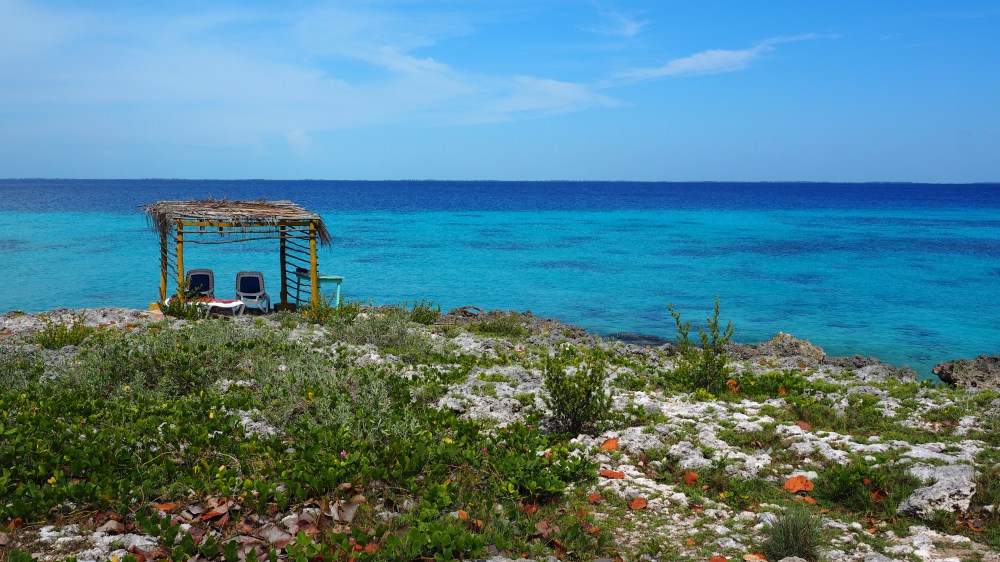Friday, 29 May 2015
Our host, Lidia, kindly organised the bus to collect us from outside the house so we did not have to travel into town to meet it. Our destination was Punta Perdiz, a popular diving location located about 10 km down the road towards Playa Larga. Our German housemates, Dennis and Gwen, had told us it was the best diving spot and so had recommended we keep it for last.
The bus collected us around 10 a.m. and it took little time to get there. The site was marked by a blue roadside restaurant built in the shape of a boat. We paid one CUC to use a little cabaña with two seats, right on the shore.

Punta Perdiz is on Playa Girón (the Bay of Pigs). It is a shallow inlet where the water is clear and you can easily see the clumps of coral. The drop-off to the deep water is clearly visible as a line of deep blue that meets the shallower aqua blue water closer to the shore.
The choice of cabaña was fortuitous because it turned out to be close to the largest outcrops of coral. The coral was not bright and colourful like the legendary psychedelic underwater seascape of Australia’s Great Barrier Reef; but there was a great variety of corals of different sizes and shapes, and together they formed an elaborate environment for a huge variety of fish.
Many of the fish inhabiting the coral were territorial. Some were quite aggressive, but it was easy to peer into their little hideouts. Susie particularly admired a fish with striking olive green and orange markings. The fish that swam in the open water between coral outcrops were seemingly accustomed to the presence of divers, and they followed us around. At one point, Susie had amassed an impressive following of elegant yellow swimmers.
We were in and out of the water all day. I did my usual trick of scouting for interesting artefacts and rubbish left by humans. Out towards the deep water, a sunken boat lay upside down on the ocean floor at a depth of between five and 10 m like a vast, sleeping whale. Because the sea was calm I might have been able to dive down to it, but I went only half way, after some encouragement from Susie. Deep water gives me a feeling of vertigo, and because the sky was overcast, it was spooky enough being suspended half way between the surface and the upturned belly of the wreck.
We had heard conflicting accounts of how the wreck occurred. According to the guidebook it was one of the sea craft scuttled during the ill-fated invasion by US-backed forces in 1961. According to some of the locals, it was a fishing boat. Whichever story is true, it was clear why Playa Girón is a Mecca for divers: the coral shelf is within tens of metres of the shore, and it plummets quickly into deep water.
As the day wore on, the sunny periods grew more intermittent. At length we packed up and prepared to board the bus again. When we arrived back at the casa, we went next door to Ronel and Yvette’s yard. Ronel is an ex-Navy diver who keeps wildlife in two enclosures. One enclosure contains jutías, or Cuban tree rats as they are called in the guidebook. The indigenous people of Cuba hunted them, and we understand that they are still used as a source of meat. They are more the size of a cat than a rat. They eat fruit and climb trees, and snuggle into the forks like koalas.
The other enclosure contains several crocodiles about a metre long. One was a Cuban croc, and two were American crocs. They coexisted with a bunch of carnivorous turtles. Ronel affectionately described the Cuban crock as a devil, as he tossed it gobbets of meat that were ravenously devoured.
We had dinner at the casa with an American couple who was staying there overnight. We chose the calamares, which were prepared in a rich dark sauce and served with rice. Conversing with the Americans was an odd experience. When we ask them how they were able to travel in Cuba they evaded the question, and some of our comments about the 1961 invasion and the economic blockade clearly offended some sensitivities. We recommended the museum to them. When they made a comment about bias, I drew a parallel with Australians visiting Vietnam: it’s important to hear the history of war told from the perspective of both sides. When I mentioned that the Vietnamese referred to the Vietnam War as ‘the American war’ I thought I saw a light go on, momentarily.
After dinner we sat out on the front porch for a while, reading books in the balmy, tropical evening. Our host, Lidia, unexpectedly gave Susie a special gift: a copy of Che Guevara’s Bolivian diary. It was a recent Spanish edition, and Lidia wrote a lovely inscription in it.
We eventually returned to the bedroom and tried to watch a Cuban film on the television. Part of the way in, Susie realised that it was based on the same story as a book she purchased in Trinidad called El que debe vivir. It was about a man who was being groomed by a counterrevolutionary conspiracy to succeed Fidel Castro. We found it impossible to follow the dialogue, however, and this was a wake-up call for us about our limited comprehension of conversational Cuban Spanish. Because Cuba has high levels of literacy and education, most of the people we met were adept at modifying their Spanish to make it more intelligible to tourists who, like us, had limited abilities in that language.